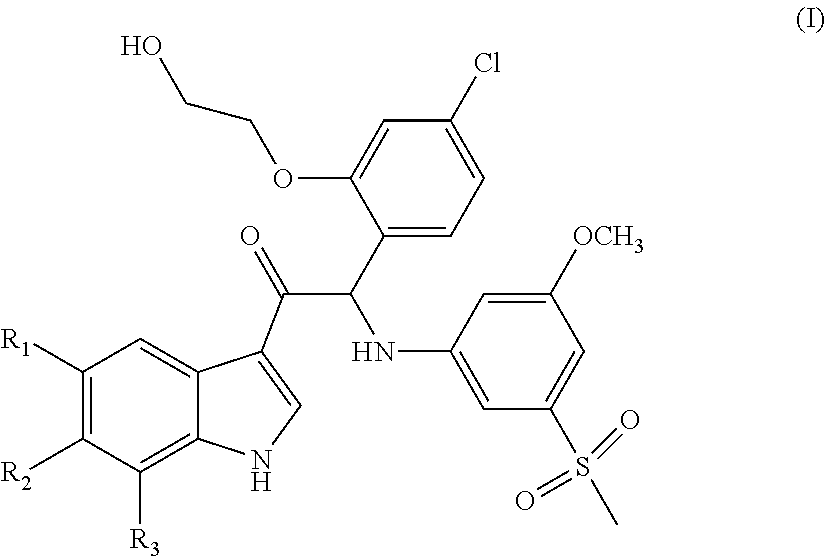Mono- or Di-Substituted Indole Derivatives As Dengue Viral Replication Inhibitors
a technology of dengue virus and indole derivative, which is applied in the field of mono- or di-substituted indole derivatives as dengue virus replication inhibitors, can solve the problems of life-threatening infections in man, dhf has become a leading cause of hospitalization and death among children in endemic regions, and the number of dengue cases is increasing, so as to achieve uniform dosage and facilitate administration.
- Summary
- Abstract
- Description
- Claims
- Application Information
AI Technical Summary
Benefits of technology
Problems solved by technology
Method used
Image
Examples
example 1
of 2-(4-chloro-2-(2-hydroxyethoxy)phenyl)-1-(6-fluoro-1H-indol-3-yl)-2-((3-methoxy-5-(methylsulfonyl)phenyl)amino)ethanone (Compound 1) and Chiral Separation into Enantiomers 1A and 1B
[0058]
[0059]Synthesis of Intermediate 1a:
[0060]A solution of 2-(4-chloro-2-methoxyphenyl)acetic acid [CAS 170737-95-8] (20 g, 101 mmol) in dry THF (300 mL) was cooled at 0° C. Oxalyl chloride (18 mL, 202 mmol) and two drops of DMF were added. The reaction mixture was stirred at room temperature for 30 min. The solvent was evaporated under reduced pressure. The residue was dissolved in ethanol (300 mL) and the reaction mixture was stirred at room temperature for 1 h. The reaction mixture was concentrated under reduced pressure to give ethyl 2-(4-chloro-2-methoxyphenyl)acetate 1a (23 g), which was used in the next step without further purification.
[0061]Synthesis of Intermediate 1b:
[0062]To a solution of ethyl 2-(4-chloro-2-methoxyphenyl)acetate 1a (10 g, 44 mmol) in CH2Cl2 (350 mL), cooled at −30° C., w...
example 2
of 1-(6-chloro-1H-indol-3-yl)-2-(4-chloro-2-(2-hydroxyethoxy) phenyl)-2-((3-methoxy-5-(methylsulfonyl)phenyl)amino)ethanone (Compound 2) and Chiral Separation into Enantiomers 2A and 2B
[0091]
[0092]Synthesis of Intermediate 2a:
[0093]Diethylaluminum chloride 1M in hexane (15.0 mL, 15.0 mmol) was added dropwise, at 0° C., to a solution of 6-chloro-1H-indole [CAS 17422-33-2] (1.52 g, 10.0 mmol) in CH2Cl2 (35 mL). After 30 min at 0° C., a solution of 2-(2-(2-(benzyloxy)ethoxy)-4-chlorophenyl)acetyl chloride 1e (5.09 g, 15.0 mmol, synthesis: see Example 1) in CH2Cl2 (10 mL) was added slowly. The reaction mixture was stirred at 0° C. for 3 h. 1 M Rochelle salt solution was added. The reaction mixture was stirred at room temperature for 1 h. The formed solids were filtered off and partitioned between EtOAc and 3N HCl. The phases were separated. The aqueous phase was extracted with EtOAc and the combined organic phases were washed with brine, dried over MgSO4, filtered and concentrated under...
example 3
of 2-(4-chloro-2-(2-hydroxyethoxy)phenyl)-1-(6-methoxy-1H-indol-3-yl)-2-((3-methoxy-5-(methylsulfonyl)phenyl)amino)ethanone (Compound 3) and Chiral Separation into Enantiomers 3A and 3B
[0116]
[0117]Synthesis of Intermediate 3a:
[0118]Diethylaluminum chloride 1M in hexane (17.2 mL, 17.2 mmol) was added dropwise, at −50° C., to a suspension of 6-methoxy-1H-indole [CAS 3189-13-7](1.69 g, 11.5 mmol) in CH2Cl2 (56 mL). After 30 min at −50° C., a solution of 2-(2-(2-(benzyloxy)ethoxy)-4-chlorophenyl)acetyl chloride 1e (5.82 g, 17.2 mmol, synthesis: see Example 1) in CH2Cl2 (23 mL) was slowly added. The reaction mixture was stirred at −50° C. for 3 h, was allowed to slowly warm to room temperature and was stirred at room temperature overnight. The reaction mixture was diluted with CH2Cl2 and was poured out into a 1M Rochelle salt solution. The mixture was stirred at room temperature for 2 h. The phases were separated. The organic phase was washed with H2O and brine, dried over Na2SO4, filter...
PUM
| Property | Measurement | Unit |
|---|---|---|
| temperature | aaaaa | aaaaa |
| wavelength | aaaaa | aaaaa |
| temperature | aaaaa | aaaaa |
Abstract
Description
Claims
Application Information
 Login to View More
Login to View More - R&D
- Intellectual Property
- Life Sciences
- Materials
- Tech Scout
- Unparalleled Data Quality
- Higher Quality Content
- 60% Fewer Hallucinations
Browse by: Latest US Patents, China's latest patents, Technical Efficacy Thesaurus, Application Domain, Technology Topic, Popular Technical Reports.
© 2025 PatSnap. All rights reserved.Legal|Privacy policy|Modern Slavery Act Transparency Statement|Sitemap|About US| Contact US: help@patsnap.com



